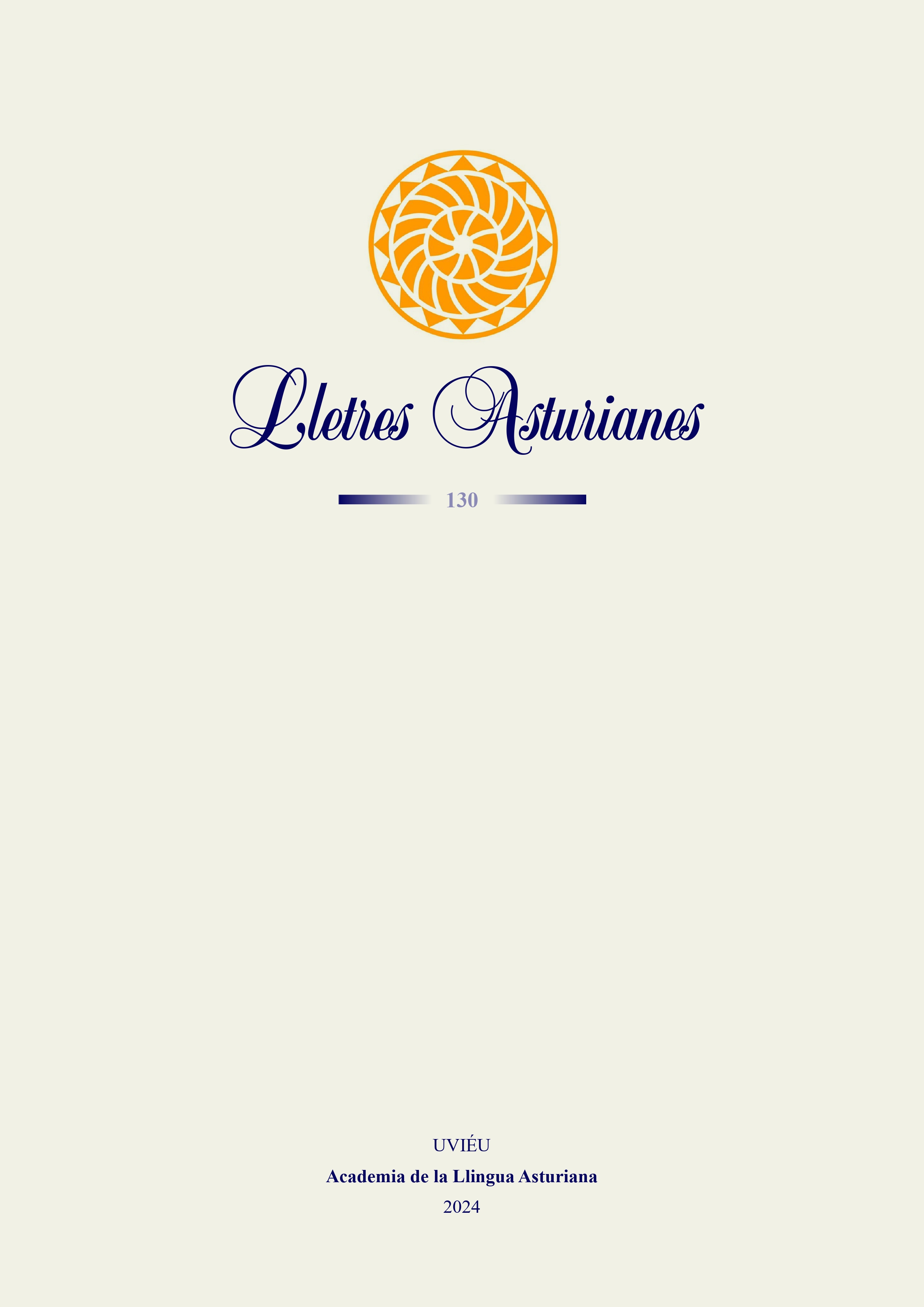Resume
Esti estudiu trata d’ufrir un analís del comportamientu funcional de les formes verbales qu’inclúin les desinencies -ra y -re n’asturianu, qu’apaecen nos tiempos verbales de pretéritu pluscuamperfeutu d’indicativu, pretéritu imperfeutu de suxuntivu y futuru de suxuntivu, comparándolu col que tienen les mesmes formes en castellanu, qu’apaecen nos tiempos verbales de pretérito imperfecto de subjuntivo y futuro imperfecto de subjuntivo, al envís de comprobar si la medría de funciones d’estes formes verbales na llingua asturiana ye quien a compensar con ésitu la so falta de formes compuestes. De mano, dempués d’ufrir una base histórica qu’esplica l’orixe y desenvolvimientu diacrónicu de los tiempos verbales en dambes llingües, muéstrase un analís de los usos funcionales de les formes verbales en -ra y -re n’asturianu n’oraciones independientes y especialmente n’oraciones complexes, en rellación col fenómenu de la concordanza de temporalidá, ye dicir, de les rellaciones temporales ente’l verbu de la oración principal y el de la subordinada. De siguío, identifíquense los contestos onde l’usu d’estes formes pue ser potencialmente ambiguu na llingua asturiana, esto ye, onde les formes verbales puen espresar más d’una rellación temporal (e. g. anterioridá, simultaneidá, posterioridá). Finalmente, dao que’l castellanu usa formes verbales compuestes nestos mesmos contestos, úfrese un analís de la frecuencia y usu d’estes formes verbales y de les construcciones perifrástiques d’orixe llatín haber + participiu y tener + participiu nun corpus de testos escritos en llingua asturiana pa comprobar si l’usu de les formes compuestes namái implica mayor variedá léxica y gramatical o, si, pelo contrario, intenta cubrir usos que los tiempos de pretéritu pluscuamperfeutu d’indicativu, pretéritu imperfeutu de suxuntivu y futuru de suxuntivu nun llogren espresar de manera eficiente. Esti analís consta de dos partes: na primera, esamínase l’usu de les formes verbales en -ra y -re nun númberu d’obres traducíes al asturianu y al castellanu y, na segunda, analícense y clasifíquense los distintos usos qu’estes formes verbales tienen nuna seleición d’obres de la lliteratura asturiana —pa evitar una posible influencia del castellanu— col fin de confirmar los resultaos llograos na etapa anterior.
Referencies bibliográfiques
Academia de la Llingua Asturiana (ALLA) (2001). Gramática de la llingua asturiana. Uviéu: Academia de la Llingua Asturiana.
Alarcos-Llorach, E. (1987). Estudios de gramática funcional del español. Madrid: Gredos.
Alarcos-Llorach, E. (1994). Gramática de la lengua española. Madrid: Espasa Calpe.
Andrés-Díaz, R. d’. (2013). Gramática comparada de las lenguas ibéricas. Xixón: Trea.
Andrés-Suárez, I. (1994). El verbo español. Sistemas medievales y sistema clásico. Madrid: Gredos.
Bello, A. (1984). Gramática de la lengua castellana. Madrid: Edaf.
Bosque, I., Acero, J. J., López-García, Á., Rojo, G. & Suñer, M. (1990). Tiempo y aspecto en español. Madrid: Cátedra.
Cano-González, A. M., Conde-Saiz, M. V., García-Arias, X. L. & García-González, F. (1976). Gramática bable. Uviéu: Naranco.
Cano-González, A. M.(1979). Estudio morfosintáctico sobre el bable del «Quixote de la Cantabria». Verba. Anuario Galego de Filoloxía 6, 75-95.
Carrasco-Gutiérrez, Á. (1999). El tiempo verbal y la sintaxis oracional. La consecutio temporum. N’I. Bosque y V. Demonte (Eds.), Gramática Descriptiva de la Lengua Española, Vol. II, pp. 3061-3128. Madrid: Espasa-Calpe.
Carrasco-Gutiérrez, Á. (2008). Tiempos compuestos y formas verbales complejas. Madrid: Iberoamericana-Veuvert.
Coseriu, E. (1976). Das romanische Verbalsystem. Tübinger Beiträge zur Linguistik 66. Tübingen: TBL-Verlag Gunter Narr.
Eguren, L. & Fernández-Soriano, O. (2006). La terminología gramatical. Madrid: Gredos.
Fernández de Castro, F. (1990). Las perífrasis verbales en español. Comportamiento sintáctico e historia de su caracterización. Oviedo: Universidad de Oviedo.
García-Arias, X. L. (2003). Gramática histórica de la lengua asturiana. Uviéu: Academia de la Llingua Asturiana.
Gili-Gaya, S. (1976) [1943]. Curso superior de sintaxis española. Barcelona: Vox.
Grandgent, C. H. (1991). Introducción al latín vulgar. Madrid: CSIC.
Junquera-Huergo, J. (1869) [1991]. Gramática asturiana. Uviéu: Academia de la Llingua Asturiana.
Neira, J. (1976). El bable. Estructura e historia. Salinas: Ayalga.
Real Academia de la Lengua Española (RAE). (2009). Nueva gramática de la lengua española. Vol. I y II. Madrid: Espasa Libros.
Viejo-Fernández, X. (1997). Las formas compuestas en el sistema verbal asturiano. Uviéu: Universidá d’Uviéu.
Viejo-Fernández, X. (1998). Les formes compuestes del verbu asturianu nel contestu hispánicu: estudiu diacrónicu y comparativu. Lletres Asturianes, 69, 27-60.
Fuentes utilizaes nel corpus
Anónimu. (2017). Llazarín de Tormes. P. Suárez García (trad.). Oviedo: Editorial Laria [Trabayu orixinal publicáu aproximadamente en 1554].
Arnaldo, P. (2015). Nel ríu la fame. Uviéu: Saltadera.
Boccaccio, G. (2018). Decamerón, P. Suárez García (trad.). Uviéu: Trabe [Trabayu orixinal publicáu ente 1351 y 1353].
Cayarga, X. (2012). Sol negru de Wewelsburg. Uviéu: Trabe.
Fernández, B. (2021). L’home les caparines. Uviéu: Ediciones Radagast.
Fernández, X. (2004). Les ruines. Uviéu: Trabe.
García, A. (1997). Díes de muncho. Uviéu: Trabe.
Herculano, A. (2017). Eurico, el presbíteru. E. García Rodríguez (trad.). Uviéu: B. Alto Creativos [Trabayu orixinal publicáu en 1844].
Twain, M. (2018). Les aventures de Huckleberry Finn. M. Baragaño (trad.). Uviéu: B. Alto Creativos [Trabayu orixinal publicáu ente 1884 y 1885].
Viejo Fernández, X. (2021). Onde’l caos se texe y se destexe. Uviéu: Trabe.
Voltaire. (2022). Cándidu o l’optimismu. Javier Martínez Concheso (trad.). Uviéu: Trabe [Trabayu orixinal publicáu en 1759].
Von Chamisso, A. (2001). Maraviyosa historia de Peter Schlemihl. X. Cayarga (trad.). Uviéu: Publicaciones Ámbitu [Trabayu orixinal publicáu en 1813].
Referencies de les traducciones dixitales en llinia
Rey-Hazas, A. & E. Alonso (trad.). El Lazarillo de Tormes (A).
https://nocturnoginer.files.wordpress.com/2019/09/lazarillo-de-tormes.-ed.-vicens-vives.pdf
Perazolo, M. et al. (trad.). Decamerón. (B).
https://www.profedelengua.es/El_Decameron_-_Giovanni_Boccaccio_-COMPLETO-.pdf
Pezzoni, E. (trad.). Cándido o el optimismo (C).
https://cdn.pruebat.org/recursos/recursos/Candido-o-el-optimismo.pdf
González-Haba, M. (trad.). La maravillosa historia de Peter Schlemihl (D).
Rodríguez-Bermejo, S. (trad.). El Monasticón: Eurico el presbítero (E).
https://ia600701.us.archive.org/27/items/euricoelpresbte00hercgoog/euricoelpresbte00hercgoog.pdf
Schuff, N. (trad.). Las aventuras de Huckleberry Finn (F).

